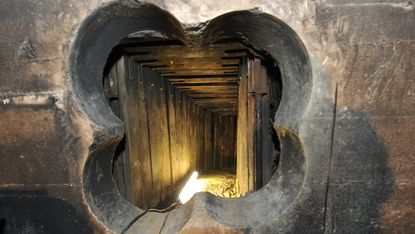The greatest robberies of the 21st century
From smash-and-grabs to underground tunnelling and cryptocurrency hacks, this century has seen it all

Two thieves made headlines around the world this week with a daring daylight heist of the Swedish crown jewels that could have come straight out of a Hollywood movie.
But it was not the first dramatic robbery this century. Here are five more:
Graff Diamonds, £40m, 2009
Subscribe to The Week
Escape your echo chamber. Get the facts behind the news, plus analysis from multiple perspectives.

Sign up for The Week's Free Newsletters
From our morning news briefing to a weekly Good News Newsletter, get the best of The Week delivered directly to your inbox.
From our morning news briefing to a weekly Good News Newsletter, get the best of The Week delivered directly to your inbox.
The Graff Diamonds heist remains Britain’s biggest jewelry raid and is among one of the smartest in history.
Ostensibly a smash-and-grab, the robbery in the heart of London involved the use of fake prosthetics, multiple getaway cars and a dark criminal overlord.
Hours before the raid, the gang’s ringleader, media-school dropout Aman Kassaye, and another man visited a Covent Garden makeup studio where they duped professional makeup artists into “ageing” them for a fictional pop video.
When they entered the Graff store on Bond Street both men proceeded to pulled out handguns and forced staff to the floor, before ordering a shop assistant to help empty rings, necklaces, watches and earrings from display cases worth £40m.
“Such an audacious robbery required meticulous planning,” reported The Guardian, “involving several hired vehicles strategically placed to block police following the getaway car.”
Four men, including Kassaye, were eventually convicted of taking part in the heist. However, at the trial the jury was told that the underworld bosses who planned it remained at large.
The vast majority of the diamonds were never recovered.
Banco Central, £55m, 2005
Considered to be one of the world’s largest ever heists, the Banco Central burglary was carried out by a small gang who tunneled 250 feet into the bank's vault.
They rented out a nearby property and disguised it as a landscape business, which allowed them to move large amounts of dirt and rock without suspicion. The tunnel took three months to construct and contained a sophisticated lighting system and even air conditioning.
The gang eventually made off with five containers of 50 Brazilian real notes, with an estimated value of £55m and weighing about 3.5 tons. None of the notes were insured and, while eight people were eventually arrested for the caper, barely any of the money was ever recovered.
Hatton Garden, £14m, 2015
While smaller in scale than other heists on the list, the Hatton Garden robbery had all the ingredients of an old-school criminal caper.
Carried out over the Easter bank holiday weekend in 2015, a gang of four men ransacked 73 boxes at Hatton Garden Safe Deposit in London's jewelry quarter after climbing down a lift shaft and drilling a hole through the six-foot vault wall.
The daring feat captured the public’s imagination, tapping into a romanticised view of a traditional bank heist.
The case received even greater attention when it was revealed it had been orchestrated by four pensioners.
Ringleaders John "Kenny" Collins, 77; Daniel Jones, 63; Terry Perkins, 69, and the group's oldest member Brian Reader, 78; pleaded guilty to conspiracy to commit burglary, after police had been tipped off by someone who had overheard them discussing the robbery in a pub.
Around £613,000 worth of valuables were found buried in a cemetery that Jones led police to, while the remainder of the £4.3m that was recovered was found at addresses linked to Perkins.
The robbery was later turned into a film starring Matthew Goode and Joely Richardson.
Coincheck Hack, £400m, 2018
Details about this audacious digital robbery - the largest in history - are still coming to light.
In January this year, executives from the Tokyo-based cryptocurrency exchange Coincheck confirmed that hackers had taken more than 500 million NEM, worth approximately £400m at the time.
While the 2014 Mt Gox hack was larger as a percentage of the total cryptocurrency market cap at the time of the theft, “in pure fiscal terms Coincheck now holds the infamous distinction of having been victim to the biggest cryptocurrency exchange hack in history”, says CCN.
Coincheck did not disclose how its system was breached, beyond saying that it wasn’t an inside job.
However, one of the stranger aspects of these heists is that because transactions for many cryptocurrencies are public, “it’s easy to see where the NEM coins are - even though they’re stolen”, says Fortune.
Coincheck has identified and published 11 addresses where all 523 million of the stolen coins ended up - but nobody knew who owned the accounts, says the magazine.
Central Bank of Iraq, £620m, 2003
This is considered the largest bank heist in history and one of the most contentious. In March 2003, just days before the US invasion of Iraq, the country’s dictator Saddam Hussein siphoned nearly $1bn from the Central Bank.
In a hand-written note, discovered a few years later, the Iraqi president had ordered the bank to give $920m (£560m at the time) and $100m (£60m) worth of euros to his son Qusay. Bank officials said Qusay personally oversaw the boxes of $100 bills loaded into trucks during a five-hour operation.
Approximately $650m, possibly part of the hoard, was later found hidden in the walls his palace. Qusay was killed by US troops in a firefight in July 2003 and less than half of the money was ever recovered.
Create an account with the same email registered to your subscription to unlock access.
Sign up for Today's Best Articles in your inbox
A free daily email with the biggest news stories of the day – and the best features from TheWeek.com
-
 'New arrivals are more than paying for themselves'
'New arrivals are more than paying for themselves'Instant Opinion Opinion, comment and editorials of the day
By Harold Maass, The Week US Published
-
 6 stylish homes in Portland, Oregon
6 stylish homes in Portland, OregonFeature Featuring a wall of windows in Collins View and a historic ballroom in Portland Heights
By The Week US Published
-
 What's next for US interest rates?
What's next for US interest rates?The Explainer Stubborn inflation forestalls anticipated rate cuts
By Becca Stanek, The Week US Published
-
 Diamond in the dust: mystery of the missing Ritz Paris ring solved
Diamond in the dust: mystery of the missing Ritz Paris ring solvedSpeed Read A £640,000 ring feared stolen from a hotel room is found – in a vacuum cleaner bag
By The Week UK Published
-
 What we know about the Copenhagen mall shooting
What we know about the Copenhagen mall shootingSpeed Read Lone gunman had mental health issues and not thought to have terror motive, police say
By The Week Staff Published
-
 Texas school shooting: parents turn anger on police
Texas school shooting: parents turn anger on policeSpeed Read Officers had to be urged to enter building where gunman killed 21 people
By The Week Staff Published
-
 DJ Tim Westwood denies multiple sexual misconduct allegations
DJ Tim Westwood denies multiple sexual misconduct allegationsSpeed Read At least seven women accuse the radio and TV presenter of predatory behaviour dating back three decades
By The Week Staff Published
-
 What happened to Katie Kenyon?
What happened to Katie Kenyon?Speed Read Man charged as police search for missing 33-year-old last seen getting into van
By The Week Staff Last updated
-
 Brooklyn subway shooting: exploring New York’s ‘steep decline in law and order’
Brooklyn subway shooting: exploring New York’s ‘steep decline in law and order’Speed Read Last week, a gunman set off smoke bombs and opened fire on a rush-hour train in the city
By The Week Staff Last updated
-
 How the Capitol attack investigation is splitting the Republicans
How the Capitol attack investigation is splitting the RepublicansSpeed Read Vote to censure two Republican representatives has revealed deep divisions within party
By The Week Staff Published
-
 Is sentencing a Nazi sympathiser to read Shakespeare an appropriate punishment?
Is sentencing a Nazi sympathiser to read Shakespeare an appropriate punishment?Speed Read Judge seemed to think introducing student ‘to high culture’ would ‘magically make him a better person’ said The Daily Telegraph
By The Week Staff Published